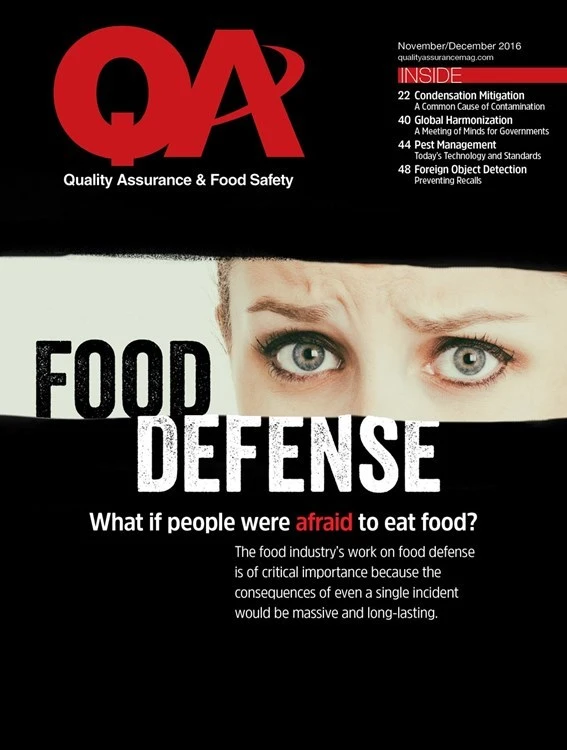

By Lisa Lupo
It’s early fall, 1984, in the city of The Dalles, Ore. It’s a typical start to the season — the leaves are changing colors, kids are back at school, and election day is fast approaching — but it is soon to become anything but typical for more than 750 people, their families, and this small community as a whole.
In what was to become the largest and best-known case of food bioterrorism in the history of the U.S. — that for more than a decade marred the reputation and travel destination of this idyllic city (and current home of Copa De Vino featured in QA’s Jan/Feb 2016 issue, bit.ly/2d35msP) — the salad bars of more than one-fourth of the city’s restaurants were intentionally contaminated with Salmonella typhimurium. But it wasn’t until a year after the event that it was confirmed as intentional contamination, when local Rajneeshee cult members admitted their guilt. The purpose had been to sicken enough of the population that voter turnout would be reduced, and the Rajneeshee turnout percentage thereby increased, so as to put their candidates into two of the three county Circuit Court seats on the ballot.
From discussion of this incident in his presentation at the 2016 Food Defense Conference presented by the Food Protection and Defense Institute (FPDI), FDA Deputy Commissioner for Food and Veterinary Medicine Dr. Stephen Ostroff moved to discussion of the 2001 anthrax attacks, in which 22 people were sickened by four postal letters that were intentionally contaminated with anthrax spores and mailed to political and media offices. While this is not a big number, Ostroff said, “The impact was massive. It shows you don’t need big numbers to have a big impact.” In addition to the five people being killed and 17 injured from contact with the spores, the incident caused postal workers and the public, across the U.S., to fear touching, much less opening, any mail.
To relate this to food, Ostroff said, “What if people were afraid to eat food? That’s why your, or should I say our, work on food defense is so very important. The consequence of even a single incident would be massive and long-lasting.”
The Food Defense Conference is FPDI’s annual two-day meeting, focused on presenting food defense topics and creating solutions that will lead to a safe, abundant food supply for all. The 2017 conference will be held May 3-4 in Minneapolis, Minn. (See Get to Know FPDI, below, for more information about FPDI. Visit http://www.thefooddefenseconference.com/about-fpdi-1 for information on the 2017 event.)

When the industry first began to focus on food defense, there was a high sensitivity on what should be publicized and what should be kept confidential so as to not give potential terrorists any ideas. While that sensitivity does still exist, Kircher said, “We recognize that we have to educate, put out narratives of things that were implemented to show that that method has been closed.”
Thus, the focus is more often on what has been corrected vs. what is still vulnerable. At the same time, however, the industry needs to understand its vulnerabilities, “so those who need to be in the know do know.”
FOOD PROTECTION AND DEFENSE. There have been various incidents of intentional contamination of food through the years, but, thus far, there has been significant differences between those of the U.S. and those of foreign origin. That is, many of those verified as intentional in the U.S. were by disgruntled workers, such as the 1996 willful tainting of a Texas hospital’s breakroom snacks by a disgruntled employee that caused illness in 12 people, and the 2003 insecticide contamination of 200 pounds of beef by a Michigan supermarket employee that caused 92 people to become ill. Examples of foreign economically motivated incidents are the China melamine contaminations of baby formula and pet food.
It is, in fact, somewhat surprising that there has not been a major intentional contamination of food in the U.S., with even a 2007 report from the Department of Homeland Security stating that, of the several types of significant adverse events that the food sector could experience, “intentional food contamination is of greatest concern to many in the food security and safety fields.” And, as far back as 2003, the FDA wrote, “If an unintentional contamination of one food … can affect 300,000 individuals, a concerted, deliberate attack on food could be devastating.”
As Ostroff also noted at the conference, “We don’t have credible evidence of a terroristic threat to the food supply, but low likelihood does not mean low consequence … and we know it has been tried.”
And those are precisely the reasons that the new Food Safety Modernization Act includes a rule on Mitigation Strategies to Protect Food Against Intentional Adulteration (IA rule), along with Preventive Control requirements to protect against economic adulteration. As is stated in the rule itself, “The purpose of this rule is to protect food from intentional acts of adulteration where there is an intent to cause wide-scale public health harm.” (See FSMA on Food Defense.)
5 STEPS TO FOOD DEFENSE. Beyond fulfilling the requirements of the law, how does a food facility integrate food defense into its daily regimen, and make it a part of the culture? Columbian Logistics Network Product Integrity Manager Ryan Skruch sees its application as a five-step process:
- Top Down. The entire organization needs to be involved, and the effort needs to be led by top executives. In addition to securing the facility and instilling tight access control, involve associates by holding “Town Hall” meetings. Allow employees to voice their concerns and empower them to speak up if they see someone in an area in which they are not authorized.
- Safety in Numbers. Skruch recommends that facilities have multiple food defense coordinators. For example, in a facility with 200 employees, 13 would be food defense coordinators. Training options for the coordinators include web-based as well as in-person, multi-day seminars, such as AIB’s two-day program, Skruch said, adding, “I recommend the two-day training. It is more expensive, but they will get more out of it.” He also recommendsed that the facility have an exposure mitigation team. To determine the focus of this, he said, “I ask, ‘What keeps you up at night?’ Then go from there.”
- Customer Cooperation. Communicating and collaborating with your clients is critical, especially if you do a lot of just-in-time processing. Skruch also recommends you conduct customer audits to ensure product is being handled as required.
- Supplier Communication and Compliance. In this case, “my way or the highway” is necessary, he said. All contractors need to be certified through your supplier program.
- Resources and Tactics. There are a number of resources for training, including those from FDA’s website (www.fda.gov), Food Safety Preventive Controls Alliance (FSPCA) (www.ifsh.iit.edu/fspca), FPDI (foodprotection.umn.edu/), and even YouTube, of which Skruch said, “We use it more than FDA.”

On the other hand, it is understandable that compliance with rules with shorter deadlines will become the priority for many companies. Because companies have at least three years for IA compliance, Kircher said, “I think companies are working toward it, but I think they’re working sequentially in order of compliance date.”
She sees the greatest compliance challenges as “getting your head around it,” Kircher said. Thinking about what could be intentionally done to harm or hurt us is not like thinking about producing food. So you have to think differently. Many facilities are also likely to be confronted with decisions on who will own the process and plan, and how to do it. “I think people have always thought about criminal activity or disgruntled employees – but there was no teeth in it. Food defense is preventive; how much time and resources do you spend on something you don’t know would happen?”
It’s a challenge because while food defense is low potential, it is of high consequence.
The author is Editor of QA magazine. She can be reached at llupo@gie.net.

Explore the December 2016 Issue
Check out more from this issue and find your next story to read.
Latest from Quality Assurance & Food Safety
- AFDO Webinar Series Offers Strategies for Difficult Times
- FDA, USDA Rehire Some Staff, Multiple Sources Report
- Nestlé Opens Arizona Beverage Factory and Distribution Center
- Ingredion Invests $100 Million in Indianapolis Plant to Improve Efficiency, Enable Texture Solutions Growth
- Eagle Unveils Redesigned Pipeline X-ray System
- USDA Invests Up To $1 Billion to Combat Avian Flu, Reduce Egg Prices
- Washington Cats Confirmed with HPAI as Investigation into Contaminated Pet Food Continues
- USDA Confirms Bird Flu Detected in Rats in Riverside





